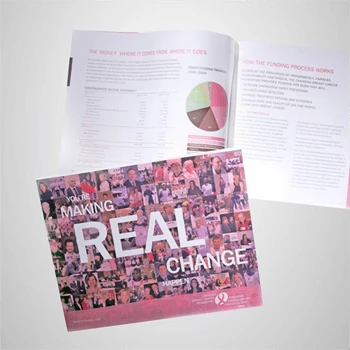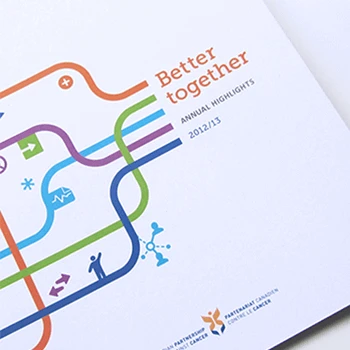What makes an annual report design truly effective for stakeholder engagement?
An effective annual report design connects your stakeholders, shareholders, and the public to your mandate and vision through intentional experience design. Today's annual reports have evolved beyond dry financial reporting to become critical touchpoints that reflect your brand personality and organizational values. Using our Experience Thinking framework, we ensure your report creates meaningful connections across all four experience areas: brand, content, product, and service delivery.
Tip: Consider how your report will be consumed across different channels - printed versions for board meetings, digital versions for online sharing, and mobile-friendly formats for accessibility.
How do you approach annual report design differently from other design projects?
Annual reports require a unique blend of regulatory compliance, brand storytelling, and stakeholder communication. We start with understanding your specific audience lifecycle - from potential investors to current shareholders to regulatory bodies. Each group has different needs and motivations when engaging with your report. Our approach ensures the timing, interaction, intensity, coverage, and meaning align with each stakeholder's expectations.
Tip: Define your primary and secondary audiences early, as this will influence design decisions from information hierarchy to visual complexity.
What's the difference between a compliance-focused report and a stakeholder-experience focused report?
A compliance-focused report meets minimum regulatory requirements but often fails to engage readers meaningfully. A stakeholder-experience focused report transforms mandatory disclosure into an opportunity for deeper connection with your audience. We design reports that fulfill compliance needs while creating an experience that builds trust, communicates progress, and reinforces your organizational brand.
Tip: Review reports from organizations you admire to see how they balance compliance requirements with engaging storytelling.
How early in the year should we start planning our annual report design?
The most successful annual reports begin planning 6-8 months before the fiscal year ends. This timeline allows for strategic content planning, stakeholder input gathering, and iterative design development. Starting early also provides time to align the report with your broader brand experience and coordinate with other organizational communications. We recommend establishing the report's strategic direction and design framework while financial data is still being compiled.
Tip: Create a content collection system throughout the year to capture key milestones, achievements, and stories that will strengthen your annual narrative.
What role does brand consistency play in annual report design?
Brand consistency in annual reporting creates trust and recognition while reinforcing your organizational identity. However, consistency doesn't mean repetition - each year's report should evolve to reflect current achievements and future direction while maintaining recognizable brand elements. Our Experience Thinking approach ensures your brand experience translates meaningfully into this critical stakeholder touchpoint.
Tip: Develop a flexible brand system for annual reports that can adapt to different themes while maintaining core visual and messaging elements.
How do you balance regulatory requirements with creative design?
Regulatory compliance provides structure, not limitations, for creative expression. We approach mandatory sections as design challenges that require clear information hierarchy, intuitive navigation, and accessible presentation. The key is understanding which elements must remain standardized and where creative interpretation can enhance comprehension and engagement. Our team works closely with legal and compliance stakeholders to ensure accuracy while maximizing visual impact.
Tip: Involve your legal and compliance representatives in early design discussions to identify flexibility within regulatory constraints.
What information architecture works best for annual reports?
Effective annual report architecture follows a logical progression from high-level vision to detailed performance metrics. We typically structure reports to begin with leadership messaging and strategic overview, progress through operational highlights and achievements, then conclude with detailed financial information and governance details. This approach respects how different stakeholders consume information - some read comprehensively while others seek specific data points.
Tip: Create clear navigation elements and cross-references to help readers who want to jump between sections or focus on specific areas of interest.
How do you handle complex financial data visualization in annual reports?
Complex financial data becomes accessible through thoughtful visualization that respects both accuracy and comprehension. We create visual hierarchies that highlight key performance indicators while providing detailed backup information for stakeholders who need deeper analysis. Our content experience approach ensures financial information supports rather than overwhelms your organizational narrative. Charts, infographics, and data visualization become tools for storytelling, not just data display.
Tip: Test financial visualizations with stakeholders who have varying levels of financial expertise to ensure broad accessibility.
What's your approach to photography and imagery in annual reports?
Photography and imagery in annual reports should authentically represent your organization's people, culture, and impact. We develop visual narratives that complement written content while avoiding stock photography that feels disconnected from your actual operations. Images become powerful tools for demonstrating organizational values and connecting stakeholders to real people and outcomes behind financial performance.
Tip: Plan photography sessions throughout the year to capture authentic moments rather than relying on posed shots taken specifically for the report.
How do you incorporate sustainability messaging into annual report design?
Sustainability messaging works best when integrated throughout the report rather than isolated in a dedicated section. We help organizations demonstrate environmental and social responsibility through both content and design choices - from paper selection and printing processes to digital-first distribution strategies. The design itself can reinforce sustainability commitments through material choices and production methods.
Tip: Consider creating both comprehensive and summary versions of your report to reduce printing while providing options for different stakeholder preferences.
What content governance process do you recommend for annual reports?
Effective content governance involves multiple stakeholders with clear roles and deadlines. We establish review cycles that allow for iterative refinement while maintaining production schedules. Key stakeholders include executive leadership for strategic messaging, finance for numerical accuracy, legal for compliance review, and communications for brand consistency. Our process includes structured feedback collection and version control to prevent confusion.
Tip: Establish a single point of contact who can make final content decisions to avoid decision paralysis during tight production timelines.
How do you ensure accessibility in annual report design?
Accessibility in annual reports means ensuring all stakeholders can engage with your content regardless of abilities or technical constraints. This includes considerations for visual accessibility through contrast and typography choices, cognitive accessibility through clear information structure, and technical accessibility through multiple format options. We design with screen readers in mind for digital versions and consider print accessibility for physical distribution.
Tip: Test your digital annual report with actual screen reader software to identify potential navigation or comprehension barriers.
What makes annual report content compelling beyond financial performance?
Compelling annual report content tells the human story behind financial numbers. We help organizations identify and articulate their impact on communities, employees, customers, and industries. Success stories, case studies, employee spotlights, and community impact narratives create emotional connections that pure financial data cannot achieve. The goal is helping stakeholders understand not just what you accomplished, but why it matters.
Tip: Collect impact stories throughout the year from different departments and stakeholder groups to create a rich narrative foundation for your report.
How do you handle multi-language requirements for annual reports?
Multi-language annual reports require careful consideration of text expansion, cultural communication preferences, and regulatory variations across jurisdictions. We design flexible layouts that accommodate different text lengths while maintaining visual consistency. Cultural considerations include color symbolism, reading patterns, and imagery preferences that may vary across regions. Our approach ensures each language version feels native rather than translated.
Tip: Involve native speakers in both translation and cultural review processes to ensure nuanced communication resonates with regional stakeholders.
What timeline should we expect for annual report design and production?
Annual report timelines typically require 12-16 weeks from initial strategic planning to final delivery, though this varies based on complexity and stakeholder availability. The process includes strategic planning (2-3 weeks), content development and design (6-8 weeks), review and revision cycles (3-4 weeks), and production and distribution (2-3 weeks). We build buffer time for unexpected revisions and regulatory changes that may impact content.
Tip: Create milestone check-ins throughout the process to address any concerns before they impact overall timeline or budget.
How do you manage version control during annual report development?
Version control becomes critical when multiple stakeholders contribute content and feedback simultaneously. We use collaborative platforms that track changes, maintain comment histories, and prevent conflicting edits. Clear naming conventions, approval workflows, and backup systems ensure everyone works from current versions while preserving revision history for reference or rollback needs.
Tip: Establish a master document owner who consolidates feedback rather than having multiple people making simultaneous edits.
What printing and production options do you recommend?
Printing and production choices should align with your brand values, budget constraints, and distribution needs. We help organizations balance quality expectations with practical considerations like quantity requirements, mailing logistics, and environmental impact. Options range from premium materials for board and investor presentations to cost-effective solutions for broader stakeholder distribution. Digital-first strategies can reduce printing needs while maintaining quality for necessary physical copies.
Tip: Order sample prints of paper stocks and binding options early in the process to make informed decisions about final production specifications.
How do you ensure quality control throughout production?
Quality control involves multiple checkpoint throughout design and production phases. We implement systematic review processes for content accuracy, design consistency, technical specifications, and production readiness. This includes proofreading at multiple stages, color accuracy verification, and production file testing. Our team coordinates with printing partners to ensure final output matches design intentions and meets distribution requirements.
Tip: Schedule a final proof review with fresh eyes from someone who hasn't been involved in day-to-day development to catch any overlooked issues.
What digital distribution strategies work best for annual reports?
Digital distribution strategies should complement your overall stakeholder communication approach. We recommend multi-channel distribution that includes website integration, email campaigns, social media promotion, and regulatory filing coordination. Interactive digital versions can enhance engagement through embedded videos, expandable charts, and linked navigation. Mobile optimization ensures accessibility across devices and platforms.
Tip: Create teaser content and key highlights for social media to drive engagement with the full report rather than expecting stakeholders to discover it independently.
How do you coordinate annual report releases with other organizational communications?
Annual report releases should integrate with broader communication strategies rather than existing in isolation. We help coordinate timing with earnings announcements, stakeholder meetings, regulatory deadlines, and other organizational communications. This coordination ensures consistent messaging and maximizes impact across all channels. The annual report becomes part of a larger stakeholder engagement strategy rather than a standalone deliverable.
Tip: Map out all organizational communications for the quarter surrounding your annual report release to identify synergies and avoid message conflicts.
What contingency planning do you recommend for annual report projects?
Contingency planning addresses potential disruptions like regulatory changes, leadership transitions, financial restatements, or external events that may impact content or timing. We build flexibility into project schedules and maintain template options that can accommodate various scenarios. Communication protocols ensure rapid decision-making when adjustments become necessary. Having backup plans reduces stress and maintains quality even when circumstances change.
Tip: Identify the latest possible date for major content changes and build project schedules that protect final production phases from last-minute disruptions.
How do you research and understand different stakeholder groups for annual reports?
Understanding stakeholder groups requires research into their motivations, information needs, and communication preferences. We conduct stakeholder analysis that examines how different groups use annual reports - from potential investors seeking growth indicators to regulatory bodies requiring compliance verification. This research informs design decisions about information hierarchy, visual complexity, and content depth. Our Experience Thinking approach ensures each stakeholder journey through the report feels intentional and valuable.
Tip: Interview representatives from key stakeholder groups about their previous experiences with annual reports to understand pain points and preferences.
What's your approach to making annual reports engaging for non-financial audiences?
Non-financial audiences connect with annual reports through stories, visuals, and outcomes that relate to their interests and experiences. We create content paths that allow different readers to find relevant information without wading through financial complexity. Impact stories, community involvement, employee achievements, and organizational culture elements create entry points for broader engagement. The design supports multiple reading patterns and levels of detail.
Tip: Create executive summaries and visual highlights that communicate key messages without requiring deep financial analysis skills.
How do you incorporate stakeholder feedback during the design process?
Stakeholder feedback integration requires structured collection and evaluation processes that balance diverse perspectives with project timelines. We create feedback frameworks that capture specific, actionable input while avoiding design-by-committee pitfalls. Regular checkpoint presentations allow stakeholders to see progress and provide input at appropriate intervals. Our goal is incorporating valuable insights while maintaining design coherence and strategic direction.
Tip: Provide specific questions or focus areas when collecting stakeholder feedback to generate more useful and actionable responses.
What research methods help improve annual report effectiveness?
Research methods for annual report improvement include stakeholder surveys, usability testing of digital versions, engagement analytics, and comparative analysis of industry standards. We also examine how stakeholders actually use annual reports through observation and interviews. This research reveals gaps between intended communication and actual stakeholder experience. Findings inform both current year improvements and strategic planning for future reports.
Tip: Track which sections of your digital annual report receive the most attention to understand stakeholder priorities and optimize future content organization.
How do you measure annual report success beyond compliance?
Annual report success measurement extends beyond regulatory compliance to include stakeholder engagement, brand reinforcement, and communication effectiveness. We track metrics like download rates, time spent reading, section popularity, and stakeholder feedback. Qualitative measures include investor relations feedback, media coverage, and internal stakeholder satisfaction. The goal is understanding whether the report achieves its intended communication and relationship-building objectives.
Tip: Establish success metrics before design begins so you can build in measurement capabilities and track performance over time.
What role do annual reports play in investor relations strategy?
Annual reports serve as foundational documents in investor relations strategies, providing detailed organizational narrative that supports other communication efforts. They establish credibility through thorough disclosure while demonstrating organizational professionalism and attention to detail. Well-designed reports become reference materials that investors return to when making decisions. The design quality and content clarity can influence perceptions of organizational competence and transparency.
Tip: Coordinate annual report messaging with your investor relations calendar to ensure consistency across presentations, calls, and written communications.
How do you address conflicting stakeholder priorities in annual report design?
Conflicting stakeholder priorities require facilitated discussion and strategic decision-making about report objectives and primary audiences. We help organizations identify which stakeholder needs are most critical to organizational success and design solutions that address primary needs while accommodating secondary concerns where possible. Clear communication about trade-offs and design rationale helps stakeholders understand final decisions even when their preferences aren't fully accommodated.
Tip: Document the reasoning behind major design decisions so you can explain choices to stakeholders and maintain consistency in future decisions.
How are you incorporating AI and automation into annual report design?
AI and automation are transforming annual report production through data visualization automation, content optimization, and production efficiency improvements. We use AI tools for initial data chart generation, content structure analysis, and accessibility checking while maintaining human oversight for strategic decisions and creative direction. AI helps streamline repetitive tasks, allowing more time for strategic thinking and stakeholder engagement. However, the human element remains essential for organizational storytelling and stakeholder connection.
Tip: Explore AI tools for initial content organization and data visualization, but ensure human review maintains your organization's unique voice and strategic messaging.
What emerging design trends are relevant for annual reports?
Emerging design trends in annual reporting include interactive digital experiences, sustainability-focused production methods, and personalized content delivery. We're seeing increased demand for modular report designs that can be adapted for different audiences and channels. However, trend adoption should align with organizational personality and stakeholder preferences rather than following fashion. Our Experience Thinking approach helps determine which innovations enhance stakeholder experience versus those that simply add complexity.
Tip: Evaluate new design trends based on how they improve stakeholder understanding and engagement rather than their novelty factor.
How do you balance innovation with regulatory and stakeholder expectations?
Innovation in annual report design must respect stakeholder expectations while finding opportunities for meaningful enhancement. We focus on innovations that improve comprehension, accessibility, or engagement without sacrificing credibility or compliance. This might include improved data visualization, better navigation systems, or enhanced digital interactivity. The key is ensuring innovations serve stakeholder needs rather than design preferences.
Tip: Test innovative design elements with a small group of stakeholders before full implementation to gauge acceptance and effectiveness.
What interactive elements work well in digital annual reports?
Effective interactive elements in digital annual reports include expandable charts, linked navigation, embedded videos, and layered information disclosure. These features should enhance rather than complicate the reading experience. Interactive elements work best when they provide additional detail for interested readers while maintaining clear primary information for quick scanning. Our goal is creating digital experiences that feel natural and intuitive rather than technically impressive.
Tip: Ensure all interactive elements have non-interactive alternatives for accessibility and printing purposes.
How do you approach responsive design for annual reports?
Responsive design for annual reports requires careful consideration of how complex financial information translates across devices. We create flexible layouts that maintain readability and functionality from large desktop screens to mobile phones. This includes adaptive typography, scalable visualizations, and touch-friendly navigation. The challenge is preserving detailed information presentation while accommodating varied screen sizes and interaction methods.
Tip: Test your digital annual report on actual mobile devices, not just browser simulations, to ensure real-world usability.
What sustainability considerations influence annual report design?
Sustainability considerations include both production methods and content messaging. We help organizations reduce environmental impact through digital-first strategies, sustainable material choices when printing is necessary, and efficient distribution methods. Sustainability messaging within the report should be authentic and supported by actual organizational practices. The design process itself can demonstrate sustainability commitments through vendor selection and production methods.
Tip: Calculate and communicate the environmental impact savings from digital distribution to reinforce your sustainability messaging.
How do you future-proof annual report designs?
Future-proofing annual report designs involves creating flexible systems that can evolve with changing regulations, technology, and stakeholder expectations. We develop design frameworks that maintain consistency while accommodating annual content variations. Technical considerations include file formats that remain accessible, design systems that scale across platforms, and content structures that adapt to new distribution methods. The goal is building foundational elements that support multi-year evolution.
Tip: Invest in design system development that can be refined annually rather than completely redesigned, reducing costs and maintaining brand consistency over time.
How do you approach annual reports for technology companies?
Technology company annual reports require balancing technical innovation narratives with financial performance and regulatory compliance. We help translate complex technological achievements into stakeholder-accessible language while maintaining credibility with technical audiences. Visual design often reflects the organization's product design sensibilities while ensuring broad stakeholder accessibility. Our experience with technology sector clients includes understanding rapid change cycles and emerging market dynamics.
Tip: Include glossaries or explanatory sections for technical terms that may be familiar to internal stakeholders but unclear to investors or regulatory audiences.
What special considerations apply to public sector annual reports?
Public sector annual reports serve citizens, elected officials, oversight bodies, and regulatory agencies with different transparency and accountability expectations. Design approaches must balance accessibility requirements with comprehensive disclosure needs. Visual presentation should reflect public trust and stewardship rather than corporate marketing sensibilities. Our government experience includes understanding complex stakeholder relationships and regulated communication requirements.
Tip: Create citizen-friendly summary versions alongside comprehensive reports to serve different stakeholder information needs and attention levels.
How do you handle annual reports for non-profit organizations?
Non-profit annual reports emphasize mission impact, community benefit, and stewardship of donor resources. Visual storytelling becomes particularly important for demonstrating program effectiveness and community connection. Financial transparency builds donor confidence while impact stories create emotional engagement. Our approach balances accountability requirements with inspirational messaging that supports continued stakeholder support and engagement.
Tip: Include specific outcome metrics and beneficiary stories that demonstrate concrete impact rather than just activity reports.
What industry-specific regulations affect annual report design?
Industry-specific regulations influence content requirements, disclosure standards, and sometimes visual presentation guidelines. Financial services, healthcare, energy, and public companies each have unique compliance requirements that affect design decisions. We work closely with regulatory and legal stakeholders to understand constraints while finding opportunities for engaging presentation within compliance boundaries. Our cross-sector experience helps navigate complex regulatory environments.
Tip: Engage regulatory specialists early in the design process to identify opportunities and constraints rather than discovering limitations late in development.
How do you approach international annual reporting requirements?
International annual reporting involves multiple regulatory frameworks, cultural communication preferences, and stakeholder expectation variations. We help organizations navigate different disclosure requirements while maintaining design consistency across jurisdictions. This includes understanding cultural color symbolism, reading patterns, and business communication norms that vary by region. Our approach ensures each market version feels native while maintaining global brand consistency.
Tip: Research cultural communication preferences and regulatory differences early to inform design decisions that work across all required markets.
What makes annual reports effective for small and medium-sized organizations?
Small and medium-sized organizations often have simpler stakeholder structures but still need professional presentation that builds credibility and trust. Design approaches can be more streamlined while maintaining quality and professionalism. Cost-effective solutions include modular design systems, digital-first strategies, and efficient production methods. The focus should be on clear communication and stakeholder confidence building within realistic budget constraints.
Tip: Focus on design elements that have the highest impact on credibility and stakeholder confidence rather than trying to include every possible feature.
How do you adapt annual report design for different organizational cultures?
Organizational culture adaptation involves understanding internal values, communication styles, and stakeholder relationship approaches that should be reflected in annual report design. Conservative organizations may prefer traditional layouts and formal language, while innovative companies might embrace experimental design approaches. Our Experience Thinking framework helps identify cultural elements that should be reinforced through design choices and messaging approaches.
Tip: Review your organization's other communication materials to ensure annual report design feels consistent with established brand personality and cultural expression.
What does the annual report design process look like when working with Akendi?
Our annual report design process begins with stakeholder discovery and strategic planning using our Experience Thinking framework. We examine your brand experience, content needs, production requirements, and service delivery objectives to create a holistic approach. The process includes collaborative workshops, iterative design development, stakeholder feedback integration, and coordinated production management. We maintain regular communication throughout while respecting internal approval processes and timeline requirements.
Tip: Prepare for initial meetings by gathering previous reports, stakeholder feedback, and examples of design approaches you find compelling or problematic.
How do you integrate with our internal communications and marketing efforts?
Integration with internal efforts requires understanding your broader communication strategy, brand guidelines, and stakeholder relationship management approaches. We work collaboratively with your internal communications, marketing, and investor relations personnel to ensure consistency and coordination. Our role is enhancing rather than replacing internal capabilities while bringing specialized annual report expertise to the process.
Tip: Identify internal stakeholders who will be involved in the process early and establish clear communication protocols to avoid confusion or duplicated efforts.
What level of involvement is expected from our internal stakeholders?
Internal stakeholder involvement includes strategic input, content development, review participation, and approval decision-making. We provide structured frameworks for collecting input efficiently while respecting busy schedules. Key stakeholders typically include executive leadership, finance, legal, communications, and subject matter experts for specific content areas. Our goal is maximizing internal expertise while minimizing disruption to daily operations.
Tip: Designate a project coordinator who can facilitate internal stakeholder participation and serve as the primary point of contact for external design professionals.
How do you handle revisions and changes during the design process?
Revision management involves structured feedback collection, change impact assessment, and clear communication about timeline and budget implications. We build revision cycles into project planning while maintaining flexibility for necessary adjustments. Our approach includes documenting change rationale and ensuring all stakeholders understand implications before implementation. The goal is accommodating legitimate needs while protecting project quality and timeline.
Tip: Gather all internal feedback before submitting revision requests to avoid multiple revision cycles that can impact timeline and budget.
What ongoing support do you provide after annual report completion?
Post-completion support includes production coordination, distribution assistance, and performance measurement guidance. We help with print vendor management, digital platform optimization, and stakeholder communication coordination. Our relationship often extends beyond single-year projects as organizations benefit from consistency and institutional knowledge. We also provide guidance for measuring report effectiveness and planning improvements for subsequent years.
Tip: Plan for post-launch distribution and communication needs early in the process to ensure seamless execution after design completion.
How do you ensure knowledge transfer to our internal personnel?
Knowledge transfer includes documentation of design decisions, file organization systems, and process insights that help internal personnel understand and maintain the work. We provide training on using design files, understanding production specifications, and maintaining brand consistency in future applications. Our goal is building internal capabilities while remaining available for future collaboration and consultation.
Tip: Identify internal personnel who will be responsible for ongoing annual report coordination and ensure they participate in key project phases for knowledge acquisition.
What makes Akendi's approach to annual report design distinctive?
Our Experience Thinking framework sets us apart by examining annual reports as complete stakeholder experiences rather than just compliance documents. We consider how your report fits into the broader ecosystem of stakeholder touchpoints and organizational communications. Our approach integrates brand experience, content strategy, product design, and service delivery perspectives to create reports that truly connect with their intended audiences. With over 220 clients across technology, energy, media, and public sectors, we bring deep cross-industry experience to each project.
Tip: Consider how your annual report connects to other stakeholder experiences throughout the year rather than treating it as an isolated communication piece.












